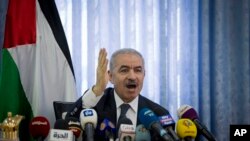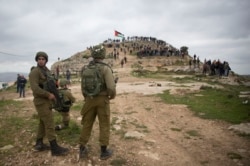It is the “moment of truth” for the international community to stand behind Palestians in the face of the intended annexation of a large portion of the West Bank by Israel, Prime Minister Mohammed Shtayyeh said Monday.
“Now that the Israeli government has loud and clear and explicitly stated that they are going to annex certain parts of Palestine, no country has an excuse not to stand [against] this injustice,” Shtayyeh told a virtual meeting of the U.N. committee that deals with Palestinian rights.
He urged the international community to impose sanctions on Israel if it carries out its annexation plans, and to bilaterally recognize Palestine as a state. The United Nations currently recognizes only a nonmember observer state of Palestine.
“That should be the most serious reply to what Israel is intending to do,” he said.
U.N. Security Council Resolution 2334, adopted in 2016, prohibits altering the demographic composition of the lands captured in 1967 and calls for the freezing of Israeli settlement expansion, which it deems illegal under international law.
Shtayyeh said the Palestinian leadership will meet Tuesday night to discuss their next steps.
After three elections and a year of unprecedented political upheaval, Israel swore in a new unity government Sunday. Incumbent Prime Minister Benjamin Netanyahu will remain in his job for 18 months. The head of the centrist Blue and White party, Benny Gantz, will be “alternate prime minister.” Then they will swap jobs.
Netanyahu reaffirmed his plans to annex about 30 percent of the West Bank, including Israeli settlements and areas populated mainly by Palestinians.
“The time has come to apply sovereignty to Jewish communities in Judea and Samaria,” he said, using the Israeli government’s term for the West Bank. “This won’t distance peace. It will bring it closer.”
Israel wants to annex about 30% of the West Bank. It seized the territory in the 1967 Six-Day War and has occupied it ever since. The Palestinians want the land to be part of their future state.
Palestinian Prime Minister Shtayyeh faulted the U.S. administration of President Donald Trump for giving Israel the “green light” for annexation in his so-called “deal of the century” peace plan, which was unveiled in January.
Last week, U.S. Secretary of State Mike Pompeo made a quick trip to Israel to urge Netanyahu not to rush to annex the territory.
“So even if Pompeo arrives in Tel Aviv to try to say whatever he said, the Israelis will not listen to him or to anybody else, because they know they enjoy a green light from the American president,” Shtayyeh said.
He said the U.S. has held an unsuccessful “monopoly” over the peace process for too long and reiterated Palestinian calls to move to a multilateral process, starting with an international conference under U.N. auspices.
*Editor's Note: An earlier version of this article inaccurately referred to areas of the West Bank subject to possible annexation by Israel as “Palestinian lands.” While home to both Palestinians and Israeli settlers, most of the areas in question were left under Israeli civil and military control by the Oslo Accords. They are considered by the United Nations to be occupied by Israel, and are described as disputed by the Israeli government.










